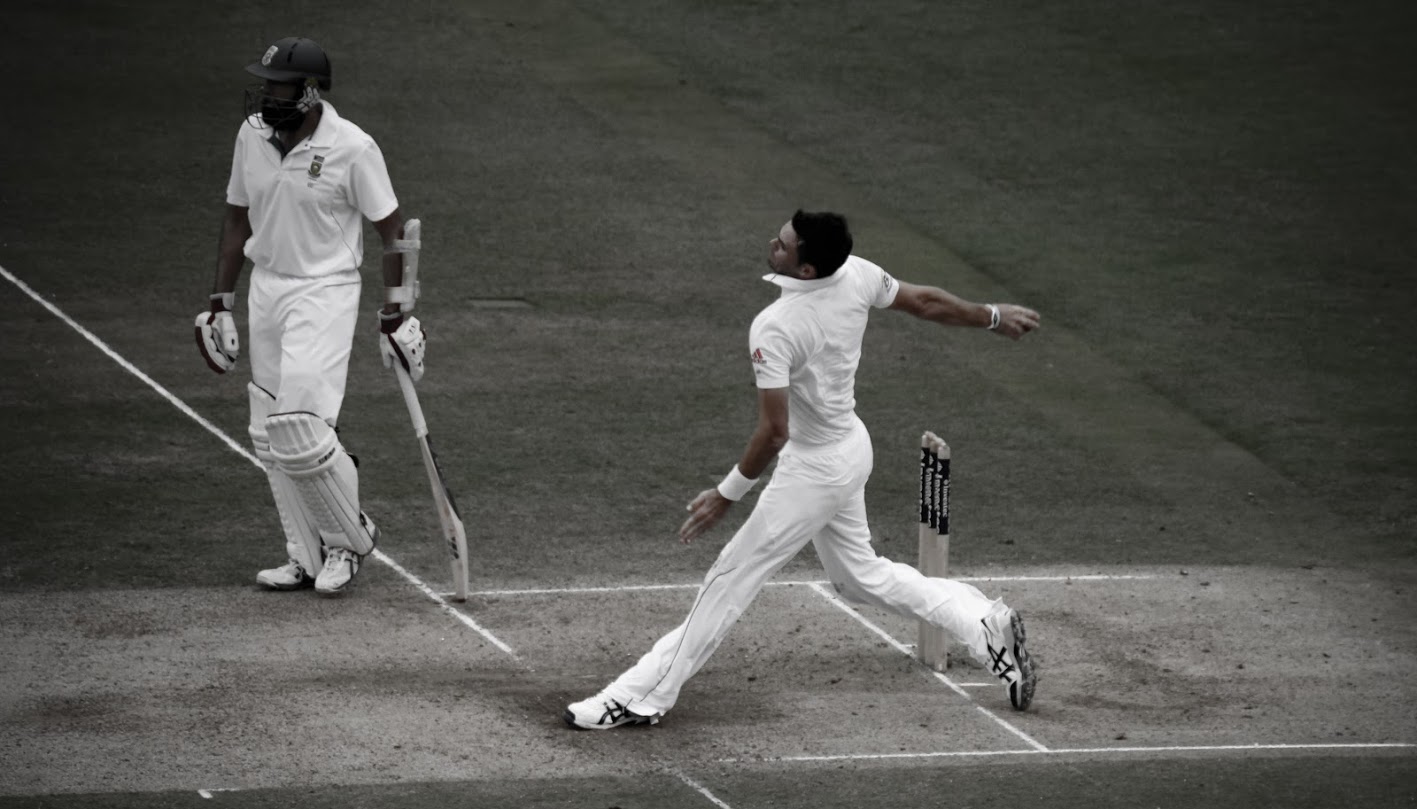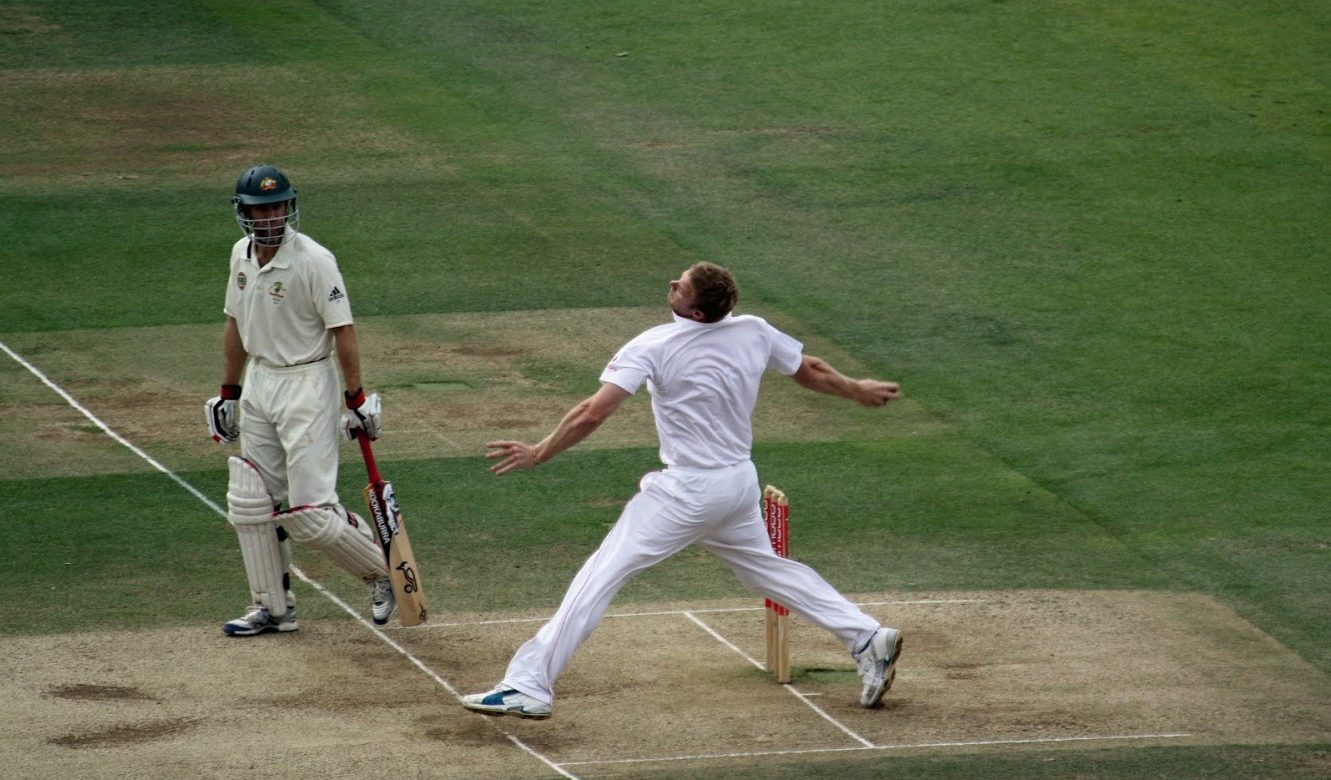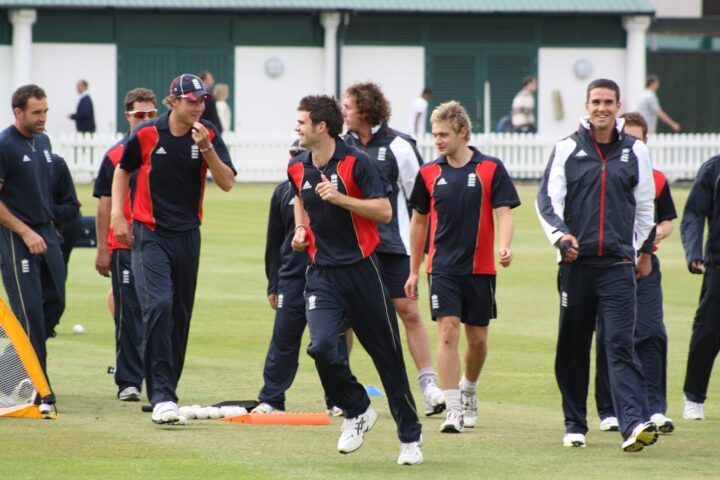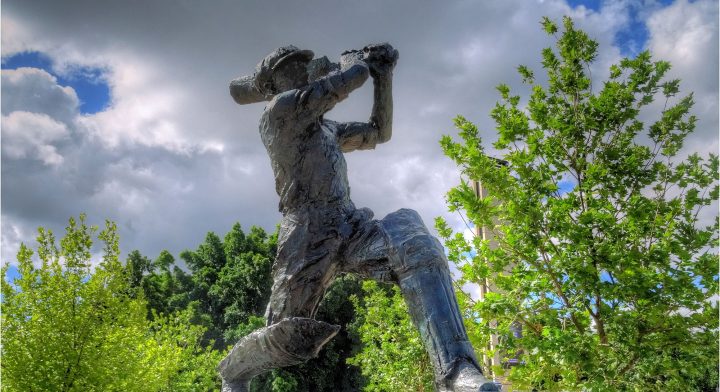Today I’d like to introduce a new TFT guest writer. His name is James Wilson. He’s a cricket author and former lawyer. I enjoyed this, and I think you will too …
Peter Jackson Eastwood’s entertaining feature on dibbly dobbler medium pacers is a reminder that cricket fans, especially English ones, have always had a soft spot for a decent cricketer who isn’t any more (or less) than that. The sort of chap who is chosen for international duties, but who turns out to be just below test standard – or, in the uncharitable parlance of the terraces, slightly crap.
Of course, how good or bad any cricketer is rather depends on one’s expectations. Averaging mid-40s with the bat would do for most, but not for someone being hailed as ‘the new Tendulkar’.
Over the years, a few players have been lumped with expectations that even genuine greats would struggle to meet, never mind an ordinary player. Australia for a time was mad enough to wonder if someone might be the ‘new Bradman’ (Doug Walters suffered that label for a short time). New Zealanders were realistic enough to know there wasn’t going to be a ‘new Hadlee’, and instead lowered their hopes to wanting ‘a partner for Hadlee’ – a new ball bowler who wouldn’t get treated like one of Mr Eastwood’s spare parts trundlers. (Sadly, even that reduced expectation never really happened in RJH’s career.)
England, however, takes no lessons from anyone when it comes to putting unfair expectations on its players. And for two decades, the cruellest expectation was the label applied to anyone who could sort of bat and sort of bowl – the ‘new Botham’.
After Andrew Flintoff’s glorious summers of 2004 and 2005, Peter Hayter in Wisden announced that the search had finally ended. In retrospect, we can see that while Fred in 2004 and 2005 played at least as well as Botham ever did, the selectors had experienced much and learned nothing. Not long afterwards, Fred was made captain and had no more joy in the role than Beefy – worse, in fact, since he suffered the bowling captain’s curse of never knowing when to take himself off.
Flintoff, then, was the exception that proved the rule. Among his predecessors, Hayter singled out David Capel, Derek Pringle, Craig White, Phil DeFreitas, Chris Lewis, Dominic Cork and Alex Tudor, whose collective stats were 198 tests, 5,253 runs at 18.49 and 542 wickets at 34.79. (In comparison, Flintoff had 79 tests, 3,845 runs at 31.77 and 226 wickets at 32.78, while Beefy managed 102 tests, 5,200 runs at 33.54 and 383 wickets at 28.40).
So, with a nod to that 2005 article, here is a team of the New Bothams, with just a slight tweak or two to incorporate a wicket keeper and a batsman who redefined the concept of unfair expectations:
1. Alex Tudor. Not exactly an opener, but nor was Beefy save for the odd ODI, so we have to make do, especially since most pseudo-Bothams were bowlers who batted a bit rather than the other way around. Besides, he scored 99 not out as a nightwatchman, so is clearly adaptable to the top order (will be pleased Graham Thorpe won’t be his partner next time he gets into the 90s).
2. David Capel. No? Well, he batted at no. 6 in 9 tests for England, which is more than most, so he therefore takes one for the team by opening. Capel told Hayter about the press following his debut in 1987: ‘If they asked, I did say, in my naivety, that I wanted to play like Botham. And somehow that would get twisted into criticism of him.’ No surprise – anything Botham himself said usually got twisted into criticism of Botham as well.
3. Graeme Hick. Some explanation here is required. Hick was not, of course, hailed as a new Botham. It was worse – he was hailed as the one and only Graeme Hick. The more county runs he scored while waiting for qualification for England, the more absurd the predictions became. In his early international days, he received too little faith, and in his later years he received too much perseverance. Hick can explain to everyone else on the team what it really means to have unfair pressure.
4. Adam Hollioke. A mixed martial artist as well as an allrounder, who will therefore handle himself in any fisticuffs with Australians or commentators. His test bowling average is actually better than his first class one, and he was a Wisden cricketer of the year in 2003. Only four tests, so another classic English 1990s career.
5. Dominic Cork. Such a glorious debut, such ridiculous expectations afterwards. I mostly remember him with genuine admiration for seizing the moment against West Indies at Lords in 2000 – Beefy would have loved that situation, and could not have done better than Cork that day even in his pomp.
6. Andrew Flintoff. Has to be included as the man who finally put a stop to all the new Botham nonsense by being the one and only Freddie Flintoff. He will also be captain, because that’s exactly what no Beefy – or Fred – should ever be. Let’s hope he uses all the bowlers at his disposal rather than overdoing it himself, and let’s hope even more that he doesn’t declare with Hick on 98.
7. Chris Lewis. Could have done so much more – the one player whose ability seems to have been of a piece with Flintoff and Botham; instead he was a prisoner of his own demons on the pitch – and ended up a prisoner of Her Majesty off it.
8. Phil DeFreitas. Probably wasn’t far wrong when he described himself as the most recalled player in history, though in fairness it is a struggle to work out how he played 44 tests with a batting average below 15 and a bowling average over 33. Always a popular chap, to add compliment to insult.
9. Geriant Jones. A few keepers have been chosen in the hope that they could bat, but if they weren’t Matt Prior or Alec Stewart (chosen as a batsman in the hope he could keep) they usually disappointed. The recall of Jones over Chris Read for the 2006/7 Ashes was not one of Duncan Fletcher’s finest moments.
10. Derek Pringle. England’s answer to Gary Sobers, except possibly in cricketing terms. Plus he was picked for the wobblers’ XI. Is there any all-time XI he wouldn’t be selected for? Opened the bowling in a World Cup and does so here as well.
11. Darren Gough. Hard to remember, but on his explosive debut (sound familiar?) he bashed a half century against the Australians, thus giving rise to hopes which swiftly vanished on the batting front, but his endless ebullience on and off the pitch always reminded one of Beefy’s attitude to life and cricket. Sharing the new ball with Pringle ensures the latter won’t get all the honours. On the subcontinent in 2000/01 he was genuinely special; shame the Australians chopped him down to size later that English summer.
12th man: A tough call here as there were so many middling players who didn’t often get the nod – Craig White for a start, or Dermot Reeve. Instead, let us choose the anti-Botham, a county journeyman who, a bit like Dave Pod, was always in with a shout of getting a sniff of a nod, Robin Martin Jenkins. He batted a bit, bowled a bit, and was nearly considered for selection. Hence as far as new Beefys are concerned, he could have been a contender to be a contender to be someone else.
And there we have it: a team which promised much once upon a time, but most of whom won’t survive the selectorial axe for long. Their best legacy (probably thanks to Flintoff) is that today’s match-winning big hitting/fast bowling all-rounder who is prone to some public vicissitudes off the pitch is never called a new Botham or a new Flintoff, but instead gets by under his own name of Ben Stokes.
© James Wilson 2018
James Wilson is the author of Court and Bowled: Tales of Cricket and the Law (Wildy, Simmonds & Hill, 2017 (2nd edn)). His website is here.









Dermot Reeve would be disqualified from contention because, although he fulfills the dodgy all rounder bit, he was the best captain England never had (and the indisputably best captain in the Championship for several years). Such abilities clearly override other considerations. And imagine the parties after winning!
• Ian Blackwell could surely do a passable impression of “Vegas Beefy” – slow bowling, hearty slogging and XL cricket pants.
• The “Scottish Beefy”, Gavin Hamilton, much like Botham V1.0, boasts eye-popping test all-rounder stats (albeit for less illustrious reasons).
• I’m also going to allow my last one just so I can use the term “Wilfully Vacuous Beefy” pinched from Andrew Miller’s excellent ESPN article about hapless tailenders (http://www.espncricinfo.com/magazine/content/story/276556.html). Alan Mullally whose sole batting performance of anything approaching substance was against Pakistan when, then coach Bumble challenged him to make 30 runs in return for 30 pints .
Rikki Clarke? The only problem being that his stats (over 2 tests) are quite good at 32 with the bat and 15 with the ball – but since both tests were against a fledgling Bangladesh this can be excused.
Gavin Hamilton is a good pub quiz qu – one test, combined wickets, runs and catches, zero. He did alright for Scotland in the 1999 World Cup (not a tournament remembered fondly by England). Did anyone buy the World Cup single?
A few years ago I had a really good cricket manager game that crashed and one of the prime ‘must have’s’ if he became available, was the aforesaid Gavin. He always seemed to make useful runs and take few wickets. He didn’t look much on screen, but maybe that will be his major legacy. Depressing for him. He’s exactly the sort of ‘package’ cricketer that our Ed would be salivating about.
The 1992 World Cup had most of these in the England team – Botham, Lewis, Hick, Pringle, Reeve and Lewis.
I remember David Capel playing all the games in England’s tour of the West Indies in 1989-90.
Chris Lewis was very talented.
So talented that he appeared twice…
:-)
I meant the 90s England all rounder Vic Lewis…
There are quite a few spinners who had genuine pretensions with ye olde willow. In the 70’s you had the like of Eddie Hemings and Vic Marks, along with the long forgotten Kim Barnett, an opening bat and very useful leg spinner. In the 80’s there was Robert Croft and in the 90’s Gareth Batty, all of these were better bowlers than the part timer Hick (a bit of a Joe Root) so Moin has a long heritage.
Genuine county all rounders like Ian Grieg, Chris Cowdrey, Alan Ealham and Ronnie Irani, also bowled plenty of overs in championship cricket, not just limited overs and all were called up for international duty. All have as valid a claim for me as Adam Hollioake, but none of them with Bothamesque pretentions apart from Grieg.
As far as a keeper is concerned I would go with Geoff Humpage. As good a keeper as Jones but a better bat, and certainly more of a Botham type cricketer.
” Australia for a time was mad enough to wonder if someone might be the ‘new Bradman’ (Doug Walters suffered that label for a short time)”.
I’m old enough to remember when Peter Toohey was dubbed “the new Doug Walters”. Toohey came into the Australian team when they lost the Packer players, scored a stack of runs against India and WI and then tanked against the 1978/79 England team. He wasn’t “the new Doug Walters” because Walters only tanked against England in England….
Wasn’t Ian Craig the first one dubbed “the new Bradman” (when he made a double century at a ridiculously young age)? Craig’s life story is a very interesting one for anyone unfamiliar with it and well worth looking up.
Hutton and Compton both reckoned that Hammond was a better bat than Bradman, and that it would have been apparent if he had taken the same approach to batting of Bradman (Bradman first, team second). I am not saying they were right, but it is difficult to think of many better placed to make the judgement.
It might be hard for anyone to remember, let alone accept, but for one week Vic Marks was the most feared English player, even in a team including Botham (near enough to his peak), Willis, Gower and Lamb. In 1983/4 England lost a test series against NZ for the first time, and then played three ODI’s. Marks had played extremely well against some provincial teams so was given a run in the ODI’s. He dismissed NZ’s folk hero, Lance Cairns, in the first game, helping secure victory for England, then routed NZ with 5/20 in the second. I remember the third as it was the first ever ODI I attended, while still in Primary School. Even though NZ had lost the series there was still a sellout crowd and consequently a great atmosphere. All the chat beforehand was how NZ might counter the new demon spin bowler (no joke). ‘Well bowled Victor’ everyone heaved with relief when he finished his spell, which Martin Crowe had played watchfully and respectfully whilst dominating the rest of the English attack.
I’m sure there were a few other ‘new Bradmans’ before Doug Walters, and I wonder if Greg Chappell suffered that label in his early days (Chappell still has a strong case to be the best Australian batsman since the war – especially when you consider the calibre of the opposition he often faced and his Packer performances).
As for the Hammond remark, I would agree about the qualifications of Compton and Hutton, allowing for a touch of English parochialism. There is certainly a great ‘what if’ concerning the first post-war Ashes in Australia, when Bradman was given a home-town decision at a crucial point, allowing him to resume control and condemn Hammond’s team to a demoralising defeat. (The context was quite fascinating – both wanting to re-establish their careers, and both would have felt the stigma of never having seen front line service during the war, whilst captaining men who had.) But let’s be realistic – would a more selfish approach have led to Hammond scoring on average another 41 runs every single innings? I’m afraid I can’t see that, or anything especially close.
If Marks had been a few inches taller he would have been an outstanding prospect. This would have given him better flight options and more bounce. On the surface he appeared fairly innocuous, but I watched him in the nets at a few times and his flight was quite deceiving, as he had that dip even as a smallish man.
You look at how height helped the likes of Roger Harper be a threat to good batsmen. If he’d bowled more overs, rather than just being a fill in for the Windies pace obsessed attack, who knows, he may have been as effective as Lance Gibbs. Hick never capitalised on his height to be a better spinner. Look at how important height is to Ashwin to get that dip and bounce.
I agree with you about the Bradman/Hammond comparison. I think it is interesting because it shows a lack of unanimity on the greatest bat of all time, unlike the question of greatest bowler where Barnes seemed to be agreed on by everyone. My understanding of the Bradman comments (which appeared in a Wisden compilation) is that Hutton was making some adjustments for wickets, with Hammond having to play more on unfriendly ones, including the famous stickies, due to English conditions. However, on that basis, perhaps a stronger case would be made for Hobbs, who played at the height of dodgy pitches (and opened, so never having the luxury of coming in against a worn old ball).
Bradman himself sang Hobbs’ praises, but again let’s be realistic, you can’t explain away over 40 runs per innings. Bradman is the greatest and any argument to the contrary just can’t get past those stats.
Barnes has amazing figures and like Bradman made his share of enemies during his career, but then George Lohman has even better stats …
Tag other Pinterest users in your pins through using “@username”
inside your descriptions. Start employing internet marketing for your
internet business today. The ropes ranged with a foot a couple of or four feet up.